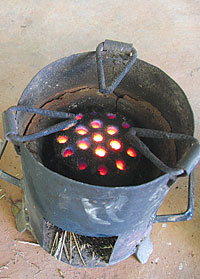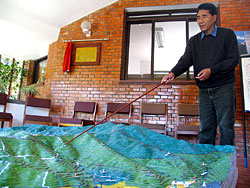|
|
| SMALL IS GREAT: Samden Sherpa uses a 3-D model of the Godavari Demonstration and Training Centre to explain the lay of the land. |
. It is hard to believe that this small hydraulic ram pump that makes a rhythmic popping sound could transform agriculture across Himalayan valleys and make farmers self-sufficient.
The ram works without electricity or diesel, it just uses the power of gravity to pump water up at least 100 m. Water comes down a thick pipe and one-third of it can be lifted through a narrower pipe for irrigation. Eighty percent of Nepalis depend on agriculture and 80 percent of their farms are rain fed-a hydraulic ram could allow monsoon-dependent farmers to grow up to three crops a year. But few farmers in Nepal use it.
. Legend has it that the ban mara weed came to Nepal through American wheat aid in the 1960s. Indigenous to Mexico it quickly spread across the tarai and midhills, smothering undergrowth and killing forests. It couldn't be used as fodder, it spread too fast to control and for decades no one knew what to do with the weed.
Now, a Nepali inventor has found a way to burn ban mara bushes and turn the ash into briquettes that can be used as fuel for special smoke-free stoves. It is cheaper than firewood, cheaper than gas or kerosene. Yet, few people use it.
. As afternoon temperature in the low valleys get up to 40 Celsius, it is difficult to keep water cool. But the technology exists to build your own cool box. Make a one-metre square box with two layers of brick and cover with it with a thatch roof. Fill the gap between the bricks with sand and keep it moist. Cover it with burlap. Voila! The temperature inside will be a constant 10 degrees below the ambient. Cooled by evaporation this contraption doesn't use any electricity. Still, virtually no one in Nepal knows about this.
 Uma Pratap, an Indian expert trains Nepali beekeepers on how to extract honey. |
The hydraulic ram, the ban mara briquette stove and the village cooler are all examples of small is beautiful technologies that have been around for decades, yet they just haven't caught on.
Scientists have often wondered why appropriate technology that is economically viable, ecologically sensible and suited to our conditions are so difficult to sell to the public. And they figured it was because they couldn't demonstrate how they worked.
"We figured we should show people how things work instead of just telling them about it," explains Milan Tuladhar of the International Centre for Integrated Mountain Development (ICIMOD) in Kathmandu, "that is why we set up this demonstration centre."
Tucked away in a side valley opposite the Botanical Garden at the base of a thickly-forested mountain in Godavari is ICIMOD's Demonstration and Training Centre for mountain agriculture. Every year, hundreds of farmers, trainers and academics from Pakistan, China, India, Bhutan and Afghanistan come to Godavari to learn about everything from terrace farming to water harvesting.
ICIMOD has set aside one hectare to demonstrate how to optimise agriculture on a sloping mountainside using simple A-frames for contours and interspersing nitrogen-fixing plants for erosion control. A water-harvesting site shows how to store rain or running water irrigation and household use with a simple impounding technique using plastic sheets.
 Ban mara briquettes burn with a clean smokeless flame. |
"We have farmers visiting us from Doti and Khotang and they actually give us ideas about improving the techniques," says Samden Sherpa who looks after the centre, "when they see it with their eyes, they think, oh I could use this back home and they immediately come up with ideas about how they could adapt it to their use."
ICIMOD's Godavari site was gifted by the government 15 years ago and is an ideal location. The Pulchoki hill that towers above is a biodiversity treasure house with at least 102 species of birds, 96 species of butterflies and is a orchid paradise with some 35 species. Of the 7,000 types of plants found on Pulchoki, 93 have medicinal properties.
"We have Pakistani and Bhutani agriculture specialists who come here and they are so impressed they want to build similar demonstration centres in their own country," says Samden.
The centre also conducts experiments in, for example, erosion control. A 30-degree slope is divided into three portions with terracing, hedgerow, without hedgerow and a control slope without terracing. The slope without terrace loses 40 tons of topsoil per hectare per year, while a terrace with peach trees at its edges loses only four tons.
On a recent visit, the centre had brought in Dr Uma Pratap from Himachal Pradesh to train a group of 20 beekeepers from across Nepal who were learning hive maintenance and honey collection techniques for Asiatic bees, which are more resistant to disease than their fussy European cousins.
Says Pratap: "I can't think of a more scenic place to learn by doing. It is much more effective than sitting in a classroom explaining people about bee hives."



